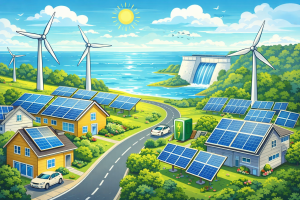Jakarta – The Gas Exporting Countries Forum (GECF) projects that demand for hydrogen can reach 550 million tonnes (mt) by 2050, or nearly 10 percent of the total energy mix.
GECF Energy Technology Analyst Seyed Mohsen Razavi said this high demand for hydrogen reflects its compatibility as an energy vector, but also highlights the need for cleaner and more efficient hydrogen production facilities. He said, environmentally friendly hydrogen produced through water electrolysis using renewable energy is estimated to reach 48 percent of production in 2050, with a production of 270 mt.
“This level of production will require an enormous amount of electricity, estimated at 12,000 kWh (TWh). This is equivalent to 43 percent of the world’s current annual electricity generation, or four times the current wind and solar generation, or the current total of electricity generation in China and the US,” said Razavi.
The Accelerated Energy Decarbonisation Scenario (AEDS) developed within the framework of the 7th edition of GECF Global Gas Outlook predicts that the total energy demand for renewable power generation is estimated at 46,000 TWh per year from solar and wind by 2050. The demand for this large amount of renewable power is more than 12 times higher than the generation currently from wind and solar, about 3,600 TWh. This need for large amounts of renewable energy makes it imperative to consider most of the hydrogen production from other available, competitive and mature methods, such as natural gas-based blue hydrogen.
AEDS estimates that around 220 mt of hydrogen will be produced using natural gas with carbon capture and storage (CCS). This accounts for 40 percent of total production by 2050. This level of hydrogen production will require more than 930 billion cubic meters of natural gas. Coal gasification with CCS is expected to contribute around 10 percent or 54 mt of hydrogen production.
“The cost competitiveness of these various hydrogen production methods is a key factor that will affect market penetration and adoption,” he added. Because, according to Seyed, the cost of blue and green hydrogen varies depending on several factors, such as location, production method, and production scale.
Blue hydrogen is a more cost competitive option than green hydrogen, as it leverages existing natural gas infrastructure and CCS technology. Currently, the average cost of blue hydrogen is estimated at around 1.5-3 USD per kilogram of hydrogen, whereas the cost of green hydrogen is higher, ranging from 3-6 USD per kilogram.
However, as renewable energy sources become cheaper and more widespread, green hydrogen is expected to improve cost competitiveness and gain a large market share. (Hartatik)














